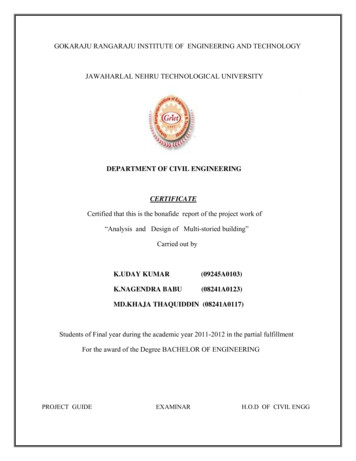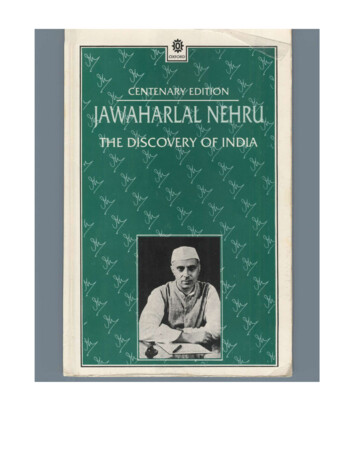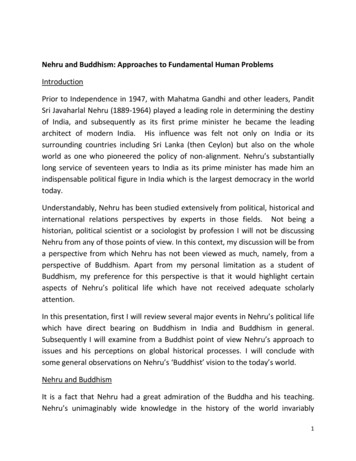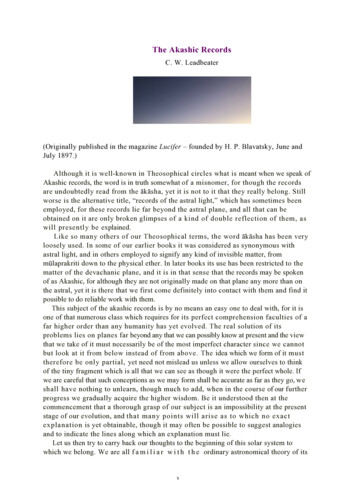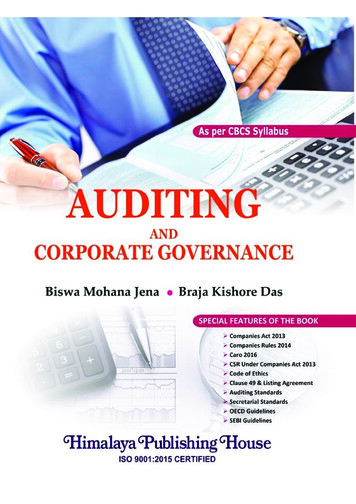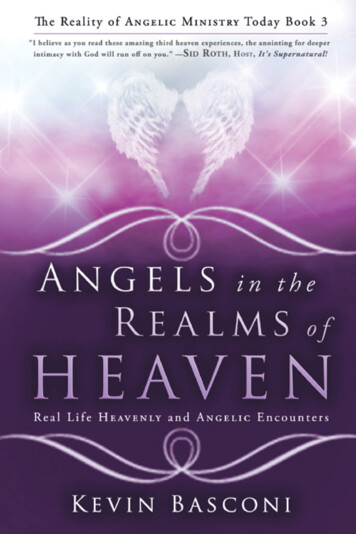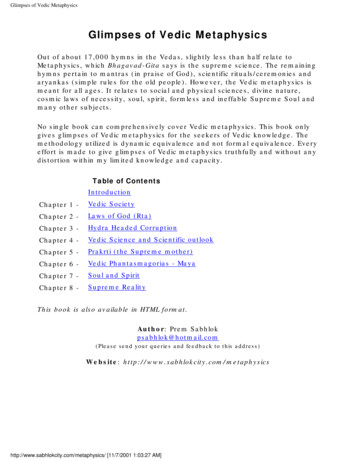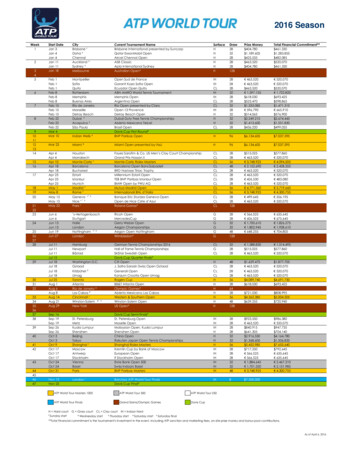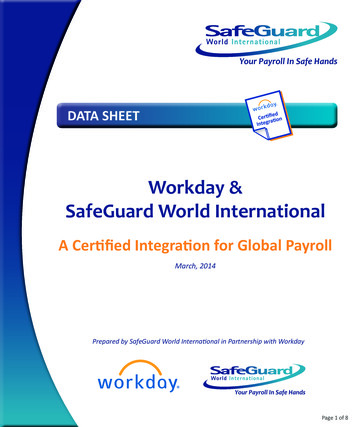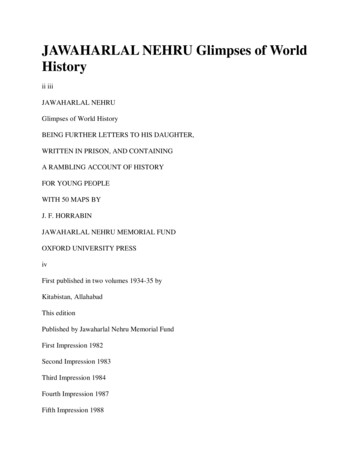
Transcription
JAWAHARLAL NEHRU Glimpses of WorldHistoryii iiiJAWAHARLAL NEHRUGlimpses of World HistoryBEING FURTHER LETTERS TO HIS DAUGHTER,WRITTEN IN PRISON, AND CONTAININGA RAMBLING ACCOUNT OF HISTORYFOR YOUNG PEOPLEWITH 50 MAPS BYJ. F. HORRABINJAWAHARLAL NEHRU MEMORIAL FUNDOXFORD UNIVERSITY PRESSivFirst published in two volumes 1934-35 byKitabistan, AllahabadThis editionPublished by Jawaharlal Nehru Memorial FundFirst Impression 1982Second Impression 1983Third Impression 1984Fourth Impression 1987Fifth Impression 1988
Sixth Impression 1989Seventh Impression 1989Eighth Impression 1992Ninth Impression 1994Tenth Impression 1995Eleventh Impression 1996Twelfth Impression 1997Thirteenth Impression 1998Fourteenth Impression 1999Fifteenth Impression 1999Sixteenth Impression 2001Seventeenth Impression 2002Eighteenth Impression 2003 Sonia GandhiSBN 19 561323 6Published by Jawaharlal Nehru Memorial FundTeen Murti House, New Delhi 110011Distributed by Oxford University PressYMCA Library Building, Jai Singh Road, New Delhi 110001Mumbai Calcutta ChennaiPrinted by Indraprastha Press (CBT), Nehru House4, Bahadur Shah Zafar Marg, New Delhi 110002v
FOREWORDMy father's three books — Glimpses of World History, An Autobiography and The Discovery ofIndia — have been my companions through life. It is difficult to be detached about them.Indeed Glimpses was written for me. It remains the best introduction to the story of man foryoung and growing people in India and all over the world. The Autobiography has beenacclaimed as not merely the quest of one individual for freedom, but as an insight into themaking of the mind of new India. I had to correct the proofs of Discovery while my father wasaway, I think in Calcutta, and I was in Allahabad ill with mumps! The Discovery delves deepinto the sources of India's national personality. Together, these books have moulded a wholegeneration of Indians and inspired persons from many other countries.Books fascinated Jawaharlal Nehru. He sought out ideas. He was extraordinarily sensitive toliterary beauty. In his writings he aimed at describing his motives and appraisals as meticulouslyas possible. The purpose was not self-justification or rationalization, but to show the Tightnessand inevitability of the actions and events in which he was a prime participant. He was aluminous man and his writings reflected the radiance of his spirit.The decision of the Jawaharlal Nehru Memorial Fund to bring out a uniform edition of thesethree classics will be widely welcomed.Indira GandhiNew Delhi4 November 1980vi viiPREFACE TO ORIGINAL EDITIONI DO not know when or where these letters will be published, or whether they will be publishedat all, for India is a strange land to-day and it is difficult to prophesy. But I am writing these lineswhile I have the chance to do so, before events forestall me.An apology and an explanation are needed for this historical series of letters. Those readers whotake the trouble to go through them will perhaps find the apology and the explanation. Inparticular, I would refer the reader to the last letter, and perhaps it would be as well, in thistopsy-turvy world, to begin at the end.The letters have grown. There was little of planning about them, and I never thought that theywould grow to these dimensions. Nearly six years ago, when my daughter was ten years old, Iwrote a number of letters to her containing a brief and simple account of the early days of the
world. These early letters were subsequently published in book form and they had a generousreception. The idea of continuing them hovered in my mind, but a busy life full of politicalactivity prevented it from taking shape. Prison gave me the chance I needed, and I seized it.Prison-life has its advantages; it brings both leisure and a measure of detachment. But thedisadvantages are obvious. There are no libraries or reference books at the command of theprisoner, and, under these conditions, to write on any subject, and especially history, is afoolhardy undertaking. A number of books came to me, but they could not be kept. They cameand went. Twelve years ago, however, when, in common with large numbers of my countrymenand countrywomen, I started my pilgrimages to prison, I developed the habit of making notes ofthe books I read. My note-books grew in number and they came to my rescue when I startedwriting. Other books of course helped me greatly, among them inevitably, H. G. Wells's Outlineof History. But the lack of good reference books was very real, and because of this the narrativehad often to be slurred over, or particular periods skipped.The letters are personal and there are many intimate touches in them which were meant for mydaughter alone. I do not know what to do about them, for it is not easy to take them out withoutconsiderable effort. I am therefore leaving them untouched.Physical inactivity leads to introspection and varying moods. I am afraid these changing moodsare very apparent in the course of these letters, and the method of treatment is not the objectiveviiione of a historian. I do not claim to be a historian. There is an unfortunate mixture of elementarywriting for the young and a discussion at times of the ideas of grown-ups. There are numerousrepetitions. Indeed, of the faults that these letters contain there is no end. They are superficialsketches joined together by a thin thread. I have borrowed my facts and ideas from odd books,and many errors may have crept in. It was my intention to have these letters revised by acompetent historian, but during my brief period out of prison I have not had the time to make anysuch arrangement.In the course of these letters I have often expressed my opinions rather aggressively. I hold tothose opinions, but even as I was writing the letters my outlook on history changed gradually.To-day if I had to re-write them, I would write differently or with a different emphasis. But Icannot tear up what I have written and start afresh.JAWAHAELAL NEHRU.January 1, 1934.ixCONTENTS
FROM CENTRAL PRISON, NAINIPAGEA Birthday Letter 11 A New Year's Gift 32 The Lesson of History 63 Inqilab Zindabad 74 Asia and Europe 95 The Old Civilizations and Our Inheritance 116 The Hellenes 137 The Greek City-States 168 Empires in Western Asia 189 The Burden of Old Tradition 2110 The Village Republics of Ancient India 2311 A Thousand Years of China 2612 The Call of the Past 2913 Where Do Riches Go To ? 3214 The Sixth Century Before Christ, and Religion 3415 Persia and Greece 3816 The Glory that was Hellas 4317 A Famous Conqueror but a Conceited Young Man 4618 Chandragupta Maurya and the Arthashastra 49FROM ON BOARD SS. CRACOVIA IN THE ARABIAN SEA19 Three Months ! 53
20 The Arabian Sea 54FROM DISTRICT GAOL, BAREILLY21 A Holiday and A Dream Journey 5522 Man's Struggle for a Living 5723 A Survey 6024 Ashoka, the Beloved of the Gods 6125 The World of Ashoka's Time 6526 The Ch'ins and the Hans 68x27 Rome against Carthage 7028 The Roman Republic becomes an Empire 7329 South India Overshadows the North 7830 The Borderland Empire of the Kushans 8131 Jesus and Christianity 8432 The Roman Empire 8733 The Roman Empire splits up and finally becomes a Ghost 9134 The Idea of the World State 9435 Parthia and the Sassanids 9736 South India Colonizes 9837 Hindu Imperialism under the Guptas 10338 The Huns come to India 10639 India's Control of Foreign Markets 10840 The Ups and Downs of Countries and Civilizations 109
41 China Flourishes under the Tangs 11342 Chosen and Dai Nippon 11743 Harsha-Vardhana and Hiuen Tsang 12144 South India Produces many Kings and Warriors and a Great Man 12645 India in the Middle Ages 13046 Angkor the Magnificent and Sri Vijaya 13347 Rome Relapses into Darkness 13648 The Coming of Islam 14149 The Arabs Conquer from Spain to Mongolia 14550 Baghdad and Harunal-Rashid 14951 From Harsha to Mahmud in North India 15352 The Countries of Europe Take Shape 15753 The Feudal System . 16254 China Pushes the Nomads to the West 16555 The Shogun Rules in Japan 169FROM DISTRICT GAOL, DEHRA DUN56 The Quest of Man 17157 The End of the First Millennium after Christ 17458 Another Look at Asia and Europe 17959 The Maya Civilization of America 18260 A Jump Back to Mohenjo-daro 18661 Cordoba and Granada 188xi
62 The Crusades 19263 Europe at the Time of the Crusades 19664 The Rise of European Cities 20265 The Afghans Invade India 20766 The Slave Kings of Delhi 21267 Chengiz Khan Shakes up Asia and Europe 21568 The Mongols Dominate the World 22169 Marco Polo, the Great Traveller 22570 The Roman Church becomes Militant 22871 The Fight against Authoritarianism 23272 The Passing of the Middle Ages 23473 The Discovery of the Sea Routes 23974 The Break-up of the Mongol Empires 24475 India Begins to Tackle a Difficult Problem 24876 The Kingdoms of South India 25377 Vijayanagar 25778 The Malaysian Empires of Madjapahit and Malacca 25979 Europe Begins to Grab in Eastern Asia 26480 An Age of Peace and Prosperity in China 26681 Japan Shuts Herself Up 27182 Europe in Turmoil 27483 The Renaissance 27784 The Protestant Revolt and the Peasants' War 281
85 Autocracy in Sixteenth- and Seventeenth-Century Europe 28586 The Netherlands Fight for Freedom 29087 England Cuts Off the Head of her King 29588 Babar 30189 Akbar 30590 The Decline and Fall of the Moghal Empire in India 31291 The Sikhs and the Marathas 31792 The English Triumph over their Rivals in India 32193 A Great Manchu Ruler in China 32794 A Chinese Emperor Writes to an English King 33195 The War of Ideas in Eighteenth-Century Europe 33596 Europe on the Eve of Great Changes 34097 The Coming of the Big Machine 34598 The Industrial Revolution Begins in England 350xii99 America Breaks Away from England 355100 The Fall of the Bastille 361101 The French Revolution 366102 Revolution and Counter-Revolution 371103 The Ways of Governments 377104 Napoleon 380105 More about Napoleon 387106 A Survey of the World 393
107 The Hundred Years before the World War 397108 The Nineteenth Century Continued 402109 Wars and Revolt in India 408110 The Indian Artisan Goes to the Wall 416111 The Village, the Peasant, and the Landlord in India 421112 How Britain Ruled India . 428113 The Reawakening of India 435114 Britain Forces Opium on China 443115 China in Difficulties 449116 Japan Rushes Ahead 453117 Japan Defeats Russia 459118 China becomes a Republic 464119 Farther India and the East Indies 468120 Another New Year's Day 475121 The Philippines and the United States of America 477122 Where Three Continents Meet 481123 A Look Back 485124 The Persistence of Iran's Old Traditions 490125 Imperialism and Nationalism in Persia 495126 About Revolutions Generally, and especially those of Eighteen Forty-eight in Europe 500127 Italy becomes a United and Free Nation 507128 The Rise of Germany 510129 Some Famous Writers 517
130 Darwin and the Triumph of Science 521131 The Advance of Democracy 527132 The Coming of Socialism 532133 Karl Marx and the Growth of Workers' Organizations 537134 Marxism 543135 The Victorian Age in England 549xiii136 England becomes the World's Money-lender 555137 Civil War in America 560138 The Invisible Empire of America 567139 Seven Hundred Years of Conflict between Ireland and England 572140 Home Rule and Sinn Fein in Ireland 578141 Britain Seizes and Holds on to Egypt 583142 Turkey becomes the " Sick Man of Europe " 590143 The Russia of the Tsars 597144 The Russian Revolution of 1905 that Failed 602145 The End of an Epoch 607146 The World War Begins 612147 India on the Eve of the War 620148 War 1914-1918 625149 The Course of the War 631150 The Passing Away of Tsardom in Russia 638151 The Bolsheviks Seize Power 645
152 The Soviets Win Through 652153 Japan Bullies China 661154 India during War-Time 667155 The New Map of Europe 674156 The Post-War World 684157 Ireland's Fight for a Republic 690158 A New Turkey Rises from the Ashes 696159 Mustafa Kemal Breaks with the Past 705160 India Follows Gandhi 711161 India in the Nineteen-Twenties 719162 Peaceful Rebellion in India 726163 Egypt's Fight for Freedom 735164 What Independence under the British Means 742165 Western Asia Re-enters World Politics 749166 The Arab Countries—Syria 755167 Palestine and Trans-Jordan 762168 Arabia—A Jump from the Middle Ages 767169 Iraq and the Virtues of Aerial Bombing 773170 Afghanistan and Some Other Countries of Asia 779171 The Revolution that Did Not Come Off 785172 A New Way of Paying Old Debts 792xiv173 The Strange Behaviour of Money 797
174 Move and Counter-Move 804175 Mussolini and Fascism in Italy 813176 Democracy and Dictatorships 820177 Revolution and Counter-Revolution in China 827178 Japan Defies the World 834179 The Union of Socialist Soviet Republics 843180 The Piatiletka, or Russia's Five Year Plan 851181 The Soviet Union's Difficulties, Failures and Successes 857182 Science Goes Ahead 865183 The Good and Bad Applications of Science 871184 The Great Depression and World Crisis 875185 What Caused the Crisis 881186 The Struggle of America and England for Leadership 888187 The Dollar, the Pound, and the Rupee 896188 The Capitalist World Fails to Pull Together 904189 Revolution in Spain 907190 The Nazi Triumph in Germany 91]191 Disarmament 922192 President Roosevelt to the Rescue 926193 The Failure of Parliaments 931194 A Final Look Round the World 936195 The Shadow of War 941196 The Last Letter 949
Postscript 954Index 972xvLIST OF MAPSPAGECivilizations of Western Asia and South-Eastern Europe 15The Beginning of Chinese Civilization 27The Greeks and the Persians 41Alexander's Empire 47Ashoka 268-226 B.C. 66Rome Becomes an Empire 75India at the Time of the Kushan Empire 82India Colonizes 100The Tang Empire 114The Arabs Conquer 147Europe in the 9th Century 159Asia and Europe about 1000 A.D. 175The Maya Civilization 184Europe in the 13th Century 198Chengiz— " The Scourge of God " 217The Discoveries 241The Revolt against Rome 282Akbar's Empire 307
The English and French Fight for India 323The Empire of Chien Lung 333America Breaks Away 357Napoleon over Europe 382India at the Time of the Great Revolt, 1857 410Britain and China 444The Growth of Japan 455Farther India and the East Indies 470The Ottoman Empire in the 16th-17th Centuries 483Russia and Persia 497Italy in 1815 508The Growth of Germany 513The Expansion of the U.S.A. 562xviBritain Seizes Egypt 585The Turk's Last Foothold in Europe 592Europe 1914-15 614Europe 1918 627Soviet Russia 1918-19 654The Succession States 675New Countries of Europe 678Mustafa Kemal Saves Turkey 698Western Asia Re-awakened 751
The Arab Countries 757Ibn Saud's Arabia 768Afghanistan 781France over Europe 806Italy and the Mediterranean 815The Chinese Revolution 829Japan's War on China 838The U.S.S.R. Opens Up Central Asia 845The War in Spain 909The Berlin-Rome Axis 969Chronological Charts xviixviiA CHRONOLOGY OF WORLD HISTORYxviii xixTO INDIRAInduDates are not very attractive things. And yet they help in putting things in their right place, sothat we may have an ordered sequence in our minds. A long list of dates is a most depressingaffair. I have arranged some important dates in a different form, as you will see. Various parts ofthe world are represented by different columns so that you can have a very rough idea at a glanceof what the world was like at a particular stage or date. Of course the idea will be very veryrough. This chronology is meant to be used for reference purposes. Having finished with it I nowfeel that I could have made a better one! But this will have to do for the present. It represents afew days' hard work.PapuDehra Dun JailAugust 22, 1933
xxA CHRONOLOGY OF WORLD HISTORYFor the very early periods of human history dates are sometimes pure guesswork. Sometimesthey are so uncertain that experts differ about them by a thousand years. The earliest remains ofhuman culture so far discovered take us back to beyond 5000 B.C. , that is to about 7000 yearsago. Egyptian history is supposed to begin then. It was the end of the age of stone. Egypt wasthen split up into many small states. Archaeologists have also discovered the early remains of acivilization, dating from about 5000 B.C, in Chaldea or Elam (Mesopotamia). The capital city ofthis was Susa. Most of the archaeological discoveries have been made in Egypt and inMesopotamia because most of the digging has taken place there. Probably similar discoveries, ofa like date, will be made in other countries also. This idea is strengthened by the next batch ofarchaeological finds which dates from about 3500 B.C. These discoveries take us right acrossAsia: from Egypt-Chaldea—Eastern Persia—Indus Valley in India—Western Turkestan—to theYellow River or Hoang-Ho in China. In all these places a common stage of development isfound. It is the end of the age of polished stone and copper is beginning to be used. There isagriculture, and domestic animals; and trade, and tools of the same type, and beautiful jewelleryof gold and silver, and painted pottery with many similar designs. Writing had already appeared.It appears that a common civilization existed at this period, about 5500 years ago, from Egypt toNorth India and China. Because of the common pottery this has been called the 'Painted PotteryCivilization.' This civilization is already so advanced, its culture and fine arts are so developed,that it has thousands of years of cultural growth behind it. This is the period of Mohenjo Daro inIndia with its fine houses and streets and artistic development. In Egypt the separate states nowjoin together to form one state under the Pharoahs-the god-kings. In Chaldea two powerful statesappear about this time-Sumer and Akkad-with a high degree of culture; and on the banks of theEuphrates stands the famous city of Ur—'Ur of the Chaldees' it is called in the Bible. From thiscommon 'Painted Pottery Civilization' the four great eastern civilizations-Egyptian,Mesopotamian (including Persian orxxiIranian), Indian, and Chinese-diverge and develop separately. Thus we have:—B.CEgyptChaldea or Elam(Mesopotamia)IndiaChinac.Common Painted Pottery Civilization3500Mohenjo Daro and Harappa inBecomes one Two powerful states—Settlements on thethe Indus Valley (Three cities3300 state underSumer and Akkad cityYellow River orone on top of the other fromPharoahs.of Ur.Hoang-Ho.B.C.3300 to B.C.2700).
It is probable that contemporaneous with the Painted Pottery Civilization in the East, thereexisted a similar civilization in the eastern Mediterranean, in the Greek Islands and the westerncoasts of Asia Minor. This early Mediterranean civilization led to the high Minoan civilization ofKnossos of about 2000-1500 B.C., which gradually decayed and became the Mycenaean orAegean civilization (of the Greek Islands) of about 1600-1100 B.C. About this time (from c.1300 onwards) the Semitic Phoenicians, the great traders of the ancient western world, come intoprominence and their settlements grow up all along the Mediterranean Coast. The city of Tyre inAsia Minor was the most important of these settlements. It was about this time also that theAryans spread out in Europe. It was these Aryan Greeks, the Hellenes, that laid siege to Troy inthe 12th century B.C. Hellenic civilization gradually developed and Hellenic colonie sprung upin Asia Minor, South Italy, Sicily, and the South of France. Homer wrote his epics in theeleventh century B.C.Meanwhile much had happened in the older centres of civilization in the East. In Egypt andChaldea empires had already flourished and decayed. In India the Aryans had establishedthemselves in the north and were pushing down to the south. They seem to have come to Indialong before they appear in Greece. They found the civilized and cultured Dravidians alreadyestablished in the country and they drove them towards South India. The Vedas were written inthe early days of the Aryan invasion, and they were followed, long afterwards, by the epics. InChina consolidation was taking place and a great State was growing up. Silk culture was alreadyknown.xxiiAnd now for our chart. But remember that the various names of civilizations and historic periods(such as Minoan, Mycenaean, Aegean, etc.), must not be taken as mutually exclusive or asindicating clearly defined periods. They are vague terms used by present day archaeologists andhistorians to distinguish various civilizations and periods which often overlap and run into eachother. Remember also that it is impossible to give the dates in the chart according to scale, thatis, giving the same space to the same length of time. It would be far better and more accurate tohave such a scale, for this would give a more correct idea of history. But such a chart wouldbecome enormously long for we have to deal with thousands of years in the early stages ofhistory, and of course the pre-historic periods are vastly bigger. So that we have to give up theidea of the scale, and sometimes an inch will do duty for a thousand years or more, and inanother place, it may represent a bare ten years or less.NOTE:—c. before a date means that the date is not exact but is approximate only. It is from theLatin circa—about.MediterraneanCoasts GreeceCarthage-Rome-EgyptWestern pire 280028002300 greatIndiaIndus Valleycivilization inNorth-west.China Koreaand Japan-
pyramids builtby Cheops,etc. GreatSphinx atGizeh.Early Mediterraneancivilization--Hyksosinvasion ofEgypt. FirstThebanEmpire from2160 to 1660.-2100Temples ofHammurabiKamak andestablishes2100Luxor built byBabylonianRameses II.Empire. City ofBabylon.Minoan Civilization ofKnossus (c. 20001500).--2000 -2356 YaoEmperor.Dravidians ingreater part ofIndia.205 Hsiadynastybegins (to1765) Silkculture.-Successivewaves of Aryansenter from Northwest andestablishthemselves inNorth.-1700 --1765 Shang orYin dynasty(to 1122).1580 SecondMycenaean civilization Theban(c. 1600-1100).Empire (to1100).-Epic period—Ramayana andMahabharat (butbooks werewritten downmuch later).--1500 ------1925 HittitesdestroyBabylonianEmpire.-Vedic periods.--2300 --Rise ofAssyrians—Aryanization ofSouth India.---
King Tiglath—Pilesar.Phoenician settlementsin the Mediterraneancity of Tyre in AsiaMinor. Aryans spread out in Europe. Siege ofTroy by HellenicGreeks 1184-1300 ---1122 Choudynasty (to255).---Palestine SaulKing of Israel.1100 David c. 1000.Solomon 9779371122 Korea.KitseestablishesVillage republicsKingdom ofof ancient India.Chosen(which laststill 193 B.C.).Hellenic colonies inAsia Minor, SouthItaly, Sicily and SouthFrance.----800 Phoenicians foundCarthage in NorthAfrica. Greek CityStates: Athens, Sparta,Thebes, Corinth, etc.800---776 Olympic gamesestablished in Greece-----728 AssyriansconquerBabylon andfound As SyrianEmpire. CapitaCity Nineveh.-700c.700 (orearlier)Panini the greatZarathushtra or grammarian.Zoroaster.--660 Japan;Small YamatoState.c. 1000 Homer writesEpics: Iliad andOdyssey.753 Rome built----------
Legendaryfirst emperorJimmu Tenno.--c 600 Sappho the greatpoetess in Lesbos.-612 AryanMedes captureNineveh anddestroyAssyrianEmpire.--600---[Probably beginnings of ancient American civilizations in Mexico, Central America and Peru,about the time – Sixth Century B.C.]Greece and Rome and CarthageEgyptWestern Asia PersiaCarthage great trade centre—dominantpower in Mediterranean.--Pythagoras in Samos c.570-504.-586 Babylonian captivity ofJews by Nebuchadnezzar.--550 Cyrus (Persian Aryan)conquers Medes.-525 Persian KingCambyses conquersEgypt.Defeats Croesus of Lydia. GreatAchaemenid dynasty begins.Empire from Hellespont toIndia.Roman Republic begins c.500. 490Battle of Marathon—Greeks repulsePersians.-Darius and Xerxes attempt toconquer Greece and fail.480 Thermopylae and Salamis.-Great City of Persepolis.Golden age of Greece: Socrates,Euripides, Pericles, Aeschylus,Sophocles, Plato, Pindar, Aristophanes. Pheidias. 404 Destruction of Athens bySparta. 359 Philip King of Macedonia.-336 Alexander the GreatAlexander defeats Darius III332 Alexander inand ends Persian Empire ofEgypt. The GreekAchaemenids. He dies atPtolemys rule Egypt. Babylon 323. His Empire splitsup.-Alexandria—a greatcentre of GreekSeleucus rules in West Asia.Hellenic dynasty of the
culture.Seleucids.264 (to 241) First Punic War—Romeagainst Carthage.-250 Iranian Parthians freethemselves, from Seleucids andestablish Arsacid dynasty (laststo A.D. 224).219 (to 202) Second Punic War.Hannibal. Roman Empire spreads toSpain, Greece, Asia Minor.--149 Third Punic War. Carthagedestroyed.--91 Civil Wars in Italy.---Roman conquests in AsiaMinor, etc. 53 Parthians defeatRomans at Carrhae.73 Revolt of slaves under Spartacus inRome. Conquest of Gaul, Britain byJulius Caesar and of eastern territoriesby Pompey.Cleopatra last48 Caesar defeats Pompey at Pharsalos. Ptolemy ruler. 3044 Caesar killed in Rome.Egypt becomes aRom. an province-B.C Buddha c.620-640.-China (and Korea andJapan)Lao-Tse 605—531.600 ------Confucius 551-429.-Mahavira (died c.467 orearlier).----Pallava traders and seamenvisit Malaysian ports.c.400 Silk exported toEurope.DateFarther India—Malaysia,etc.India (and Central Asia)500 400Pallavas dominant inextreme South of India.-Alexander's raid in NorthIndia 326. 321Chandragupta—Chanakya—Maurya Empire begins—'Arthashastra'. 303 Seleucusdefeated-300Pataliputra great Capital CityChinese settle in Indo-China.Taxila— Ujjain—Mathura.--268 Ashoka (to 226) GreatEarly Pallava settlements—Empire almost whole IndiaFarther India, Eastern Islands,and part of Central Asia.etc.Buddhist missionaries sent to255 Ch'in dynasty.
foreign lands.220 Growth of Andhrapower in South. Great200 Southern Empire lasting to 3rd century A.C. Pallavas inextreme South.-Indo-Scythians come fromnorth-west and settle inPunjab—Rajputana—Kathiawar. c.150 Patanjali.Kushan Empire in NorthIndia and Central Asia—100from Benares to Yarkand.Buddhist Turki dynasty.-Close intercourse betweenIndia and Graeco-Romanworld and Central Asia.249-209 Shih Huang Ti.Burning of Books. GreatWall completed 204. 202Han dynasty (to 221 A.C.)-[KOREA: 193 Ki-Tsedynasty ends]Capital Peshawar(Purushapura)—Lasts till 3rdcent A.C. contemporaneouswith Andhra Empire in South.Chinese conquer and annexAnnam.140-86 Wu Ti Emperor.Contacts with Japan andRome. 108 North Koreaconquered by Chinese.-(JAPAN: Yamato still asmall state.) Literary CivilService Examination systembegins in China. Lasts 2000years. Printing fromwooden blocks invented.Roman EmpireWestern AsiaDateB.C.100--27 B.C. Octavian Caesar becomes Princeps. The Chief andImperator. Roman Empire begins.---Jesus born at Nazarethin Palestine.B.CAC.14-180 Emperors: Tiberius, Caligula, Claudius, Nero,Vespasian, Titus, Domitian, Nerva, Trojan, Hadrian, Antonius,Marcus Aurelius.--[Maya and Aztec Civilizations in America develop in secondcentury A.C. Strongly organized States, many cities—art—architecture, etc.]-A.C.100-224 Sasanid Empire inPersia begins. Stronglynationalist Iranian andZoroastrian (lasts till652).200-272 Arab desert state of300Palmyra ends. Zenobia
Queen.306 Constantine the Great Emperor. Capital taken to Byzantiumwhich becomes Constantinople. Christianity becomes officialreligion of Empire. Division of Empire into Western andEastern.-c.400 Barbarian attacks on Rome 410 Goths under Alariccapture and sack Rome. 450 Huns under Attila overrun Gaul andItaly and are finally defeated in 451 at the Battle of Chalous inFrance. 455 Vandals under Genseric sack Rome. 476 WesternEmpire ceases to exist. The Goth Odoaca King in Italy. OtherGoth Kings. 481 Clovis of France.400Eastern Roman Empire with Capital a Constantinople continuesthough much weakened by Barbarian and Hun attacks. Revives under Justinian who reigns from 527 to 565.500Farther India—Malaysia, etc.IndiaGreat schism in Buddhism—Mahayana and Hinayana.Organized expeditions ofPallavas to found colonies inMalaysia and Eastern Islands.Development of maritimetrade.ChinaJapan andKorea--Important Indian (Pallava)colonies establishedespecially at Cambodia,Sri Vijaya in Sumatra.South Malay, Central Java,Eastern Bomeo.---Buddhism introducedinto China. Later HanEmperors drive Tartarswest. (These go later toEurope and India asHuns, etc.).--221 Han dynasty falls.---Three kingdoms.---336 Samudragupta. Extensiveconquests.-Yamato(Japan)expandsabout 350.380 Vikramaditya Kalidas,--320 Gupta Empire in NorthIndia begins Nationalistrevival—Renaissance. Capital Ayudhva. Golden age ofSanskrit. 320 Chandragupta.--
the poet. Fa-Hien, Chinesepilgrim, visits India.c.450 Hun invasion of India.---Toroman the Hun establisheshimself in North India. 495.--Mihiragula, the Hun. 510-28.525 Bodhidharma theHindu States in Indopatriarch of Indian Buddhism China.leaves India to settle in China.Bodhi dharma reachesCanton.-Western Europe-Eastern EuropeWestern AsiaFrequent wars betweenByzantine(Constantinople)Empire and Sasanid(Persian) Empireweakening both.Central Asia-Mixed IndoChinese-Persianculture in CentralAsia. Buddhismwide-spreadamong Turks andother races.--570 Mohamad born (dies632) at Mecca, SasanidEmpire extends to Egypt,Syria, Asia Minor, Persiaunder Khusrau II. 619.--622 Hegira. The flight toMedina. 632. Abu BakrCaliph. 634 Omar Caliph.-Byzantine Empiredefeated by Arabs butpreserves itself.632-70 Arabs defeatByzantine Empire andconquer Persia, EgyptNorth Africa and parts ofCentral Asia. CapitalDamascus. OmmayadCaliphs (Sasanid Empireended by Arab Conquest).Chinese Tangsextend in the Northtowards theCaspian Sea. Arabconquests inCentral Asia.711 Arab conquest ofSpain from NorthAfrica. Invasion ofFrance. 732 Battle ofTours in France.Charles Martel defeatsArabs and stops Arabinvasion.--750 Arab kingdom of750 Ommayad CaliphsArab Empire--
Cordoba in Spain.Famous city andUniversity.-overthrown. AbbasideCaliphate begins. Spainbecomes independent Arabkingdom underOmmayades. Arab Empireshrinks but consolidation.Capital goes to Baghdad.786 (to 809) Haroun-alRashid Caliph. Brillia
My father's three books — Glimpses of World History, An Autobiography and The Discovery of India — have been my companions through life. It is difficult to be detached about them. Indeed Glimpses was written for me. It remains the best introduction to the story of man for young and growing

